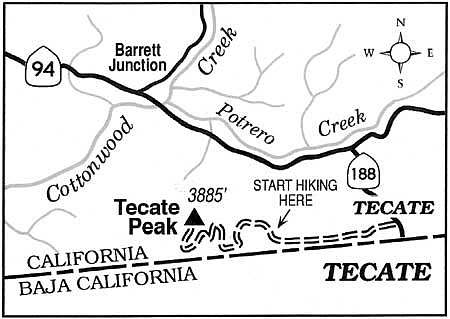 Facebook
Facebook
 X
X
 Instagram
Instagram
 TikTok
TikTok
 Youtube
Youtube
Tecate Peak straddles the U.S./Mexico border, overlooking the twin towns of Tecate, California and Tecate, Baja California. Kumeyaay Indians called this peak "Kuchumaa," and believed that a holy power, for healing or harm, emanated from the mountain's granitic boulders. According to oral historical accounts, shamans from tribes involved in disputes would meet at the summit for peace conferences. Archaeological evidence suggests that the mountain was also used for fertility ceremonies. Even today, descendants of the Kumeyaay, who have been granted vehicle access to the upper slopes of the mountain, make periodic journeys to its summit.
The Tecate Peak slopes within California lie largely in the public domain, on lands under the jurisdiction of the federal Bureau of Land Management and the California Division of Forestry. In 1958 a dirt road was constructed on the mountain's eastern slope to serve an antenna site on the summit. A locked gate along this road bars unauthorized vehicles, but not hikers and mountain bikers. Therefore, you can enjoy a reasonably pleasant and traffic-free -- though often long, hot, and sweaty -- journey to the summit and back.
To reach the starting point from San Diego, drive east on Highway 94 (Campo Road) toward Jamul and Campo. At a point 19 miles beyond Jamul, turn south on Highway 188 toward the Tecate border crossing, which is only 2 miles farther. Don't cross the border into Mexico. Instead, turn west on an unpaved road, just 0.4 mile shy of the border itself. That road swings south, hugs the border for a while, then turns northwest and starts climbing. A locked gate blocks the road 2.8 miles from Tecate, and you must find parking where you can below that.
Your hike or bike up the mountain first takes you through chamise chaparral, spiced with yerba santa, and then, higher up, through low-growing carpets of a shrub called southern mountain misery. Mountain misery's sticky, fernlike foliage exudes an aroma similar to witch hazel. Clusters of white flowers, resembling strawberry blossoms, appear on it during early spring.
At a point about a mile above the gate, hikers have the option of cutting off about 0.4 mile of tedious road walking by following the top edge of a huge, tilted granite slab bordering a ravine to the right. After about 100 yards of climbing, you can rejoin an upper level of the roadway. This is the most worthwhile of several possible shortcuts on the way to the summit. Mountain bikers will find it reasonable to just stick with the road route all the way.
The commanding view from the summit includes most of San Diego County and vast stretches of northern Baja California. To the east there's an almost aerial view of the twin border towns. You can see the sharp, arrow-straight delineation between Tecate, California (population around 100), and Tecate, Mexico, with an expanding population of over 100,000. The landmark Tecate brewery is visible near the center of town.


Tecate Peak straddles the U.S./Mexico border, overlooking the twin towns of Tecate, California and Tecate, Baja California. Kumeyaay Indians called this peak "Kuchumaa," and believed that a holy power, for healing or harm, emanated from the mountain's granitic boulders. According to oral historical accounts, shamans from tribes involved in disputes would meet at the summit for peace conferences. Archaeological evidence suggests that the mountain was also used for fertility ceremonies. Even today, descendants of the Kumeyaay, who have been granted vehicle access to the upper slopes of the mountain, make periodic journeys to its summit.
The Tecate Peak slopes within California lie largely in the public domain, on lands under the jurisdiction of the federal Bureau of Land Management and the California Division of Forestry. In 1958 a dirt road was constructed on the mountain's eastern slope to serve an antenna site on the summit. A locked gate along this road bars unauthorized vehicles, but not hikers and mountain bikers. Therefore, you can enjoy a reasonably pleasant and traffic-free -- though often long, hot, and sweaty -- journey to the summit and back.
To reach the starting point from San Diego, drive east on Highway 94 (Campo Road) toward Jamul and Campo. At a point 19 miles beyond Jamul, turn south on Highway 188 toward the Tecate border crossing, which is only 2 miles farther. Don't cross the border into Mexico. Instead, turn west on an unpaved road, just 0.4 mile shy of the border itself. That road swings south, hugs the border for a while, then turns northwest and starts climbing. A locked gate blocks the road 2.8 miles from Tecate, and you must find parking where you can below that.
Your hike or bike up the mountain first takes you through chamise chaparral, spiced with yerba santa, and then, higher up, through low-growing carpets of a shrub called southern mountain misery. Mountain misery's sticky, fernlike foliage exudes an aroma similar to witch hazel. Clusters of white flowers, resembling strawberry blossoms, appear on it during early spring.
At a point about a mile above the gate, hikers have the option of cutting off about 0.4 mile of tedious road walking by following the top edge of a huge, tilted granite slab bordering a ravine to the right. After about 100 yards of climbing, you can rejoin an upper level of the roadway. This is the most worthwhile of several possible shortcuts on the way to the summit. Mountain bikers will find it reasonable to just stick with the road route all the way.
The commanding view from the summit includes most of San Diego County and vast stretches of northern Baja California. To the east there's an almost aerial view of the twin border towns. You can see the sharp, arrow-straight delineation between Tecate, California (population around 100), and Tecate, Mexico, with an expanding population of over 100,000. The landmark Tecate brewery is visible near the center of town.
